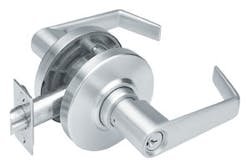With the demand for security and the availability of technology both increasing, door control systems that locksmiths are expected to provided have evolved from a lock and key to a multi-technology system solution.
A door control system provides for the physical locking (security) of an opening, but enhanced capabilities also enable the enrolling and deleting of access privileges for system users, the archiving and creation of system activity logs (reports) and an assortment of remote door monitoring and control capabilities.
The role of the locksmith in the design of a door control system may include consulting with the client to determine what combination of components and features will best meet the client’s requirements with respect to security, management features, reliability and of course, cost.
Some things are not negotiable
A brief digression: Occasionally, you may find yourself in a situation where you’re feeling like you’re “negotiating” elements of your system proposal with a client. In these situations, the client is trying to get a lower price from you, or is trying to get out of the repairing a door or running cable, so they figure they’ll try their hand at system design. When faced with a situation like this, remember that certain things should never be “negotiable”.
1- Life safety: Your design should hold life safety as the number one priority. No corner can be cut; no safety feature can be omitted.
2- Your reputation: If you allow the “tail to wag the dog,” that is, allow the client’s inexperience and fiscal obsessions to compromise your design, the resulting inadequate system will reflect poorly on you and your company. You will be remembered as the outfit that installed a poor system and not the “good guys” who were the cheapest.
3- Your bottom line: Shortcuts seem to always come back to haunt you. Intermittent system issues will result in phone calls and callbacks, both taking up time which will eat away at your bottom line. They are not usually billable.
Accessing what they need
Your survey question will include:
- How many employees will be issued a credential or granted access privileges?
- Is there a high turnover rate of employees or is an increase in the number of employees anticipated?
- What is the type of occupancy?
- Are certain areas open to the public?
- Are hazardous materials stored/used on site?
- Are the premises or materials in the premises subject to defense department or homeland security regulation (etc.)?
- Are the provisions for ADA already in place?
- Is there a fire alarm? Does it currently control the exits?
- Who is the LAHJ (Local Authority Having Jurisdiction) for the locations?
- How many doors need to be controlled? Is the number expected to increase?
- At how many physical locations are the doors located?
- Is there network or other existing infrastructure between the locations?
- Are there any computers or related resources available?
- Are there receptacles or circuit breakers available to power the new system?
- What types of doors are involved (metal, wood, aluminum, fire-rated, etc.)? What kinds of locks are used on them?
- Is the existing key system master keyed and well managed, with all keys accounted for?
You must ask the right questions in order to get the right answers; and you need to develop a solid overview of the client’s facility liabilities, resources and operation in order to propose and deliver a professionally engineered door control system.
Site surveys are frequently chaotic and distracting. Often the person who has been delegated to show you around will not have the answers to all your questions or be the decision maker. Take detailed notes to the greatest extent possible.
Develop a site survey script. This will ensure you will get at least some information on your client and your survey will not end up being a waste of both your time. Follow-up questions and calls are inevitable, but the more organized you are during the survey, the better the first impression with the client, and your relationship will start off on the right foot towards developing a successful door control system plan.





